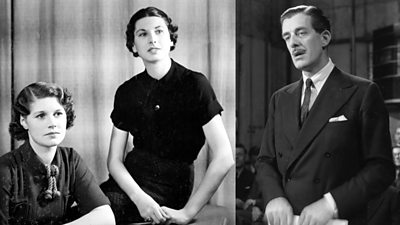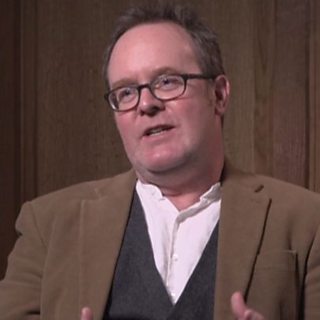Once the Selsdon Inquiry had agreed that the ����ý should run Britain’s first television service, preparations began in earnest in 1935: facilities were built, people hired, and on-air talent discovered.
For a few months, there were still test transmissions involving Baird’s old 30-line service. But even Baird – who’d since improved his own system to run on more lines – admitted his original ‘low-definition’ system was no longer sustainable, and in September 1935 the ����ý stopped using it completely. The several thousand ‘televisors’ bought by the public for watching television since 1928 - designed only for 30-lines - were suddenly useless. And for the next 11 months, there were no regular television broadcasts at all.
The ����ý was taking advantage of this lull in public activity to decide the shape and character of its future ‘high definition’ service, using images of 405 lines. A ‘Director of Television’ was appointed – Gerald Cock.

Although Cock answered directly to senior radio figures in Broadcasting House, he immediately raised eyebrows among the ����ý old guard by setting out a strikingly populist vision. In 1935, announcers on the radio were anonymous, dignified to the point of icy aloofness, and tended to speak with what the writer Compton MacKenzie described as “synthetic, plus-fours gentility”. Cock wanted television announcers to have “a pleasant personality and informed manner”. Some six hundred applied, and three were chosen – two women and one man: Jasmine Bligh, Elizabeth Cowell, and Leslie Mitchell.

Lighting, design, and engineering staff were also recruited – and everyone moved to the newly-acquired, though still rather tumble-down Alexandra Palace, in North London. From deep inside this sprawling, adapted Victorian fun-palace, the very first live ‘high definition’ television programmes intended for the public were broadcast by the ����ý on Wednesday 26th August 1936 - to the Radiolympia Exhibition, held annually in London for showing-off new radio equipment to the public:
In the newsreel report, we saw Helen Mackay singing ‘Here’s Looking at You’. It offers a glimpse of the programme at the heart of the ����ý’s broadcasts to Radiolympia in August and September 1936: a variety show with exactly the same title. Its producer was Cecil Madden – a key figure in early television, since he was to be in day-to-day charge of all output until the service closed at the outbreak of war in 1939. In the interview he recorded for the ����ý Oral History Collection, Madden described how this, the ����ý’s very first ‘regular’ programme, came about:
At the Radiolympia Exhibition itself, members of the general public watched by standing inside tiny darkened viewing boxes – each person being allowed one minute. A waiting room at London’s Waterloo railway station was also equipped with a receiving set. As a publicity stunt, even an airplane was equipped to receive programmes as it flew over the city.
By the end of the Exhibition, Madden and his team had broadcast twice a day for ten days - twenty performances of what one reviewer called his “miniature variety show”. Most newspaper reports concentrated on the technical achievement rather than the performers on screen. The Times, for instance, told readers that programmes “came over with perfect synchronization of sound and vision and with complete continuity of movement”. The Observer, however, did actually comment on the show itself, describing it as “a gem”. Madden’s own judgement was a little more realistic. “It improved daily and by the end was reasonable”.
Despite all the publicity, probably only about 300 members of the public actually saw the Radiolympia broadcasts. This means eye-witness accounts are now extremely rare. Fortunately, the ����ý’s oral history interview with Grace Wyndham Goldie – a leading figure in ����ý Television in the 1950s and 1960s – provides one for us. In 1936, she was working as a radio critic for The Listener magazine, when she decided to speak to its editor, Rex Lambert, about the work going on at Alexandra Palace:
Grace Wyndham Goldie’s rather brutal judgement – that “the whole thing was terrible” – hadn’t stopped her recognising television’s innate potential. As the cultural historian Joe Moran points out in his book, Armchair Nation: an Intimate History of Britain in Front of the TV, television sustained itself in these early days “not on its mildly disappointing present but on dreams of its future”.
One reason for the ‘mildly disappointing present’ in the case of the Radiolympia broadcasts is that they were never actually intended to begin as soon as they did. The ����ý’s Alexandra Palace team were supposed to be getting everything ready for the official November 1936 launch. But, as Cecil Madden reveals in this short video interview, his boss, Gerald Cock, felt compelled to launch something extra early as a result of disappointing sales news from the Exhibition:
There were other technical difficulties being grappled with behind-the-scenes. Camera-operators discovered that the images in their viewfinders were upside down. ‘Cuts’ from one camera to another were not yet possible - only slow ‘fades’ lasting at least eight seconds.
By far the biggest problem, though, was that the Selsdon Inquiry had obliged the ����ý to use both the new electronic system developed by Marconi-EMI and the rather cumbersome mechanical system developed by Baird. As the ����ý engineer, Tony Bridgewater explains in his oral history interview, this meant broadcasts constantly alternating between the two systems – with two studios, two ways of processing the image, two sets of cameras:
Once the Radiolympia broadcasts were over, there was a brief pause in the ����ý’s television service. All effort was now focused on the official launch on the 2nd November of what would be the first regular ‘high definition’ television service in the world.
Search by Tag:
- David Hendy
- Voices of the ����ý
- Birth of TV
- Selsdon Inquiry
- Baird 30 line system
- Marconi 405 line system
- Televisor
- Gerald A. Cock
- ����ý Broadcasting House
- Elizabeth Cowell
- Leslie Mitchell
- Alexandra Palace
- Radiolympia Exhibition
- Thank You Ally Pally
- Helen Mackay
- Here’s Looking at You
- Cecil Madden
- Grace Wyndham Goldie
- Tony Bridgewater
- Jasmine Bligh

